

The home of Scrum > Assessments > Professional Scrum Developer Assessments > PSD Objective Domain. Process Domain The Scrum Framework Scrum theory includes time-boxing, and specific roles, rules, and artifacts.
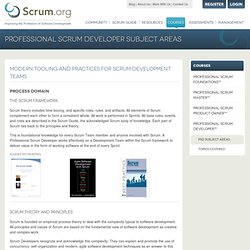
All elements of Scrum complement each other to form a consistent whole. All work is performed in Sprints. All base rules, events, and roles are described in the Scrum Guide, the acknowledged Scrum body of knowledge. This is foundational knowledge for every Scrum Team member and anyone involved with Scrum. Suggested Reading Scrum Theory and Principles. Lean Startup – nie chodzi o koszty ale o sens. Autor prowadzi blog - ProductLabs.pl W trakcie jednego roku Lean Startup okrzyknięto prawie religią w Pao Alto i jeszcze w tym samym roku niektórzy zaczęli mieć dość powtarzania, że to jedyna słuszna droga.

Moim zdaniem wszystko zależy od tego czy interesującą ideę szybko przetestujemy na nasze potrzeby biznesowe czy będziemy wirtualnie dyskutować o „lepszości” jednej idei nad inną. Lean management. Lean management (ang.) – jedna z koncepcji zarządzania przedsiębiorstwem, której wdrożenie umożliwia dostarczanie klientowi wymaganej przez niego wartości po jak najniższym koszcie i przy wykorzystaniu jak najmniejszej ilości zasobów.
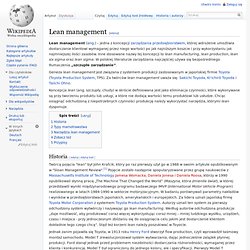
Inne stosowane nazwy tej koncepcji to lean manufacturing, lean production, lean six sigma oraz lean sigma. W polskiej literaturze zarządzania najczęściej używa się bezpośredniego tłumaczenia „szczupłe zarządzanie”. Geneza lean management jest związana z systemem produkcji zastosowanym w japońskiej firmie Toyota (Toyota Production System, TPS). Za twórców lean management uważa się: Sakichi Toyoda, Ki'ichirō Toyoda i Taiichi Ohno. Koncepcja lean (ang. szczupły, chudy) w skrócie definiowana jest jako eliminacja czynności, które wykonywane są przy tworzeniu produktu lub usługi, a które nie dodają wartości temu produktowi lub usłudze. Agile Branching Strategies. Someone once asked me if adoption of Agile methods results in changing your branching strategy.
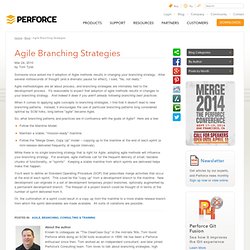
After several milliseconds of thought (and a dramatic pause for effect), I said, "No, not really. " Agile methodologies are all about process, and branching strategies are intimately tied to the development process. It's reasonable to expect that adoption of agile methods results in changes to your branching strategy. And indeed it does if you aren't already following branching best practices. When it comes to applying agile concepts to branching strategies, I find that it doesn't lead to new branching patterns. FeatureBranch. Version control · continuous integration.

Svn - Best branching strategy when doing continuous integration. Agile. Version Control for Multiple Agile Teams. If we have several agile development teams working on the same codebase, how do we minimize the risk of stumbling over each other?
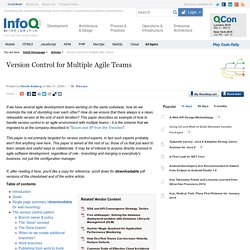
How do we ensure that there always is a clean, releasable version at the end of each iteration? This paper describes an example of how to handle version control in an agile environment with multiple teams - it is the scheme that we migrated to at the company described in "Scrum and XP from the Trenches". This paper is not primarily targeted for version control experts, in fact such experts probably won't find anything new here. This paper is aimed at the rest of us, those of us that just want to learn simple and useful ways to collaborate. It may be of interest to anyone directly involved in agile software development, regardless of role - branching and merging is everybody's business, not just the configuration manager.
Table of contents Introduction. ObjectMother. Testing tags: An object mother is a kind of class used in testing to help create example objects that you use for testing.
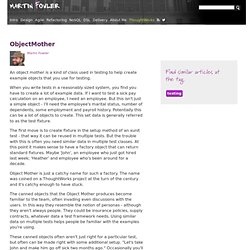
When you write tests in a reasonably sized system, you find you have to create a lot of example data. If I want to test a sick pay calculation on an employee, I need an employee. But this isn't just a simple object - I'll need the employee's marital status, number of dependents, some employment and payroll history. The first move is to create fixture in the setup method of an xunit test - that way it can be reused in multiple tests. Object Mother is just a catchy name for such a factory. The canned objects that the Object Mother produces become familiar to the team, often invading even discussions with the users. These canned objects often aren't just right for a particular test, but often can be made right with some additional setup.
Object Mothers do have their faults. Agile Product Ownership in a nutshell. This is basically a 1 day product ownership course compressed into a 15 minute animated presentation.

There’s obviously more to product ownership than this, so see this is a high level summary. Here’s the complete drawing (.png format)Here’s a downloadable version of the video, in case you don’t want to stream (.mov format, 90 Mb) Special thanks to Alistair Cockburn, Tom & Mary Poppendieck, Jeff Patton, Ron Jeffries, Jeff Sutherland, and Michael Dubakov for providing many of the models, metaphors, and ideas that I use in this presentation. Translations: (see also the translation guide by Cédric Chevalerias) French (subtitles)French (voice)German (subtitles)German (voice)Portuguese (voice)Spanish (subtitles) Below is a full transcript in english.
Let’s talk about Agile software development from the perspective of the Product Owner. Here’s Pat. Here are the stakeholders. The stakeholder needs are expressed as user stories. Now, somebody has to BUILD the system. This queue needs to be managed.